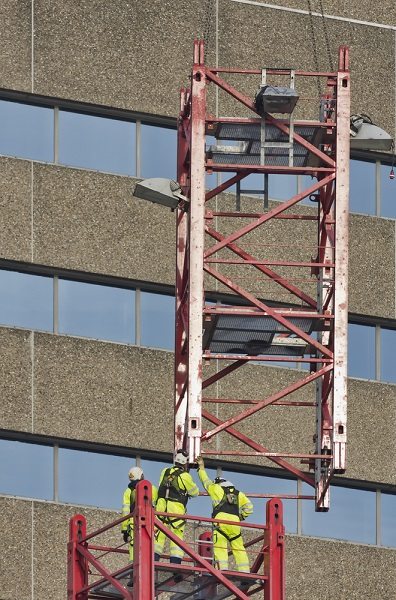
Fall protection can slip to the back of anyone’s mind, even experienced professionals. But it is crucial workers and their supervisors stay on top of U.S. Occupational Safety and Health Administration (OSHA) fall protection regulations as well as plain common sense measures at work sites. If an effort isn’t made to keep fall protection at the forefront of workers’ minds, then it is likely bad and life-threatening habits will start to form. Six-foot ladders and single-story-tall roofs may not seem very scary or dangerous to experienced workers, but falling from these heights can be just as fatal as falling from the top of a cell tower.
Considering falling can cause traumatic brain injuries, broken bones and death, workers and businesses should take every precaution possible to rid workers of bad habits and reduce the risk of anyone falling on the job.
Is your fall protection information up to date?
First and foremost, all managers, supervisors and anyone responsible for worker safety should review what they know about fall protection regulations. Many laws have evolved in the past few years, meaning you may not know the most recent regulation if you haven’t stayed informed.
For instance, the American National Standards Institute used to say fall protection equipment had a five-year life. Now, ANSI states equipment should be retired when it is no longer safe and useful, according to Occupational Health and Safety.
All protection equipment needs to be inspected at least twice a year – and before each use – for wear and tear so that it is retired when it’s not up to the task, Industrial Maintenance and Plant Operation Magazine reported.
Know what protection is needed and when
Knowing OSHA regulations is half the battle of protecting workers. The other half is understanding which fall protection equipment is best depending on the situation.
For instance, a restraint system is typically a harness or lanyard that keeps a worker from reaching a fall hazard, such as the edge of a roof, while a positioning system is a harness connected a vertical surface and is needed for when employees are working on a wall, pole or tower.
Workers can’t just use whatever system they want. Instead, the fall protection equipment used should provide the stability and safety needed for the specific project and worksite.
Don’t believe the edge protection myth
Many workers and businesses think that if employees are more than 6 feet from the edge of a precipice they don’t need fall protection, but this is not true. OSHA does not provide a safe distance from the edge that negates fall protection requirements. Instead, employees working more than 5 feet from the ground in general industry and 6 feet from the ground in commercial circumstances needs to have a personal fall-arrest system or some other protection, such as guardrails.
Create a comprehensive response plan
Businesses need to create a system for addressing a fall emergency and train all workers on the proper procedure, not only because OSHA requires a prompt rescue of workers who have fallen, but also because emergency response personnel often lack the knowledge and equipment for how to get someone down from a tall height. Emergency response plans should guide workers in how to safely rescue a fallen worker and help response personnel when they arrive on the scene.
Border States offers a suite of services and solutions to meet your needs, including but not limited to training opportunities, job site trailers and containers, tool repair and service, kitting and more.
Call and let us help meet all of your supply, service and solution needs (866-483-7289).
Read more:
Best Practices to Ensure Ladder Safety
After A Serious Workplace Incident, Don’t Forget to Help the Witnesses
Be Safe and Plan Ahead: FR, Heat and Staying Cool
OSHA Highlights Fall Prevention
The Risks of Working with High Voltage
Linemen: Safety is Everything
The Importance of Effective Communication on Pipeline Projects
Preventing Slips and Falls – Consider Cleats
E-commerce offerings:
(Contact a Customer Service Representative for additional selections, options, and solutions)
Fall Protection
First Aid
Signaling
Lineman Tools
Ladders
Harnesses
Heat Stress
Did you know that any customer is eligible for online ordering? All you need to do is fill out this online form.
Key benefits include:
- Order anytime, 24/7, 365 days a year. If you can connect, you can place an order.
- Create order templates, aka “My Lists.” Reduce search time, click, order, done.
- Track purchase history and view your account information. You can review invoices any time, track purchase history, and print or download records.